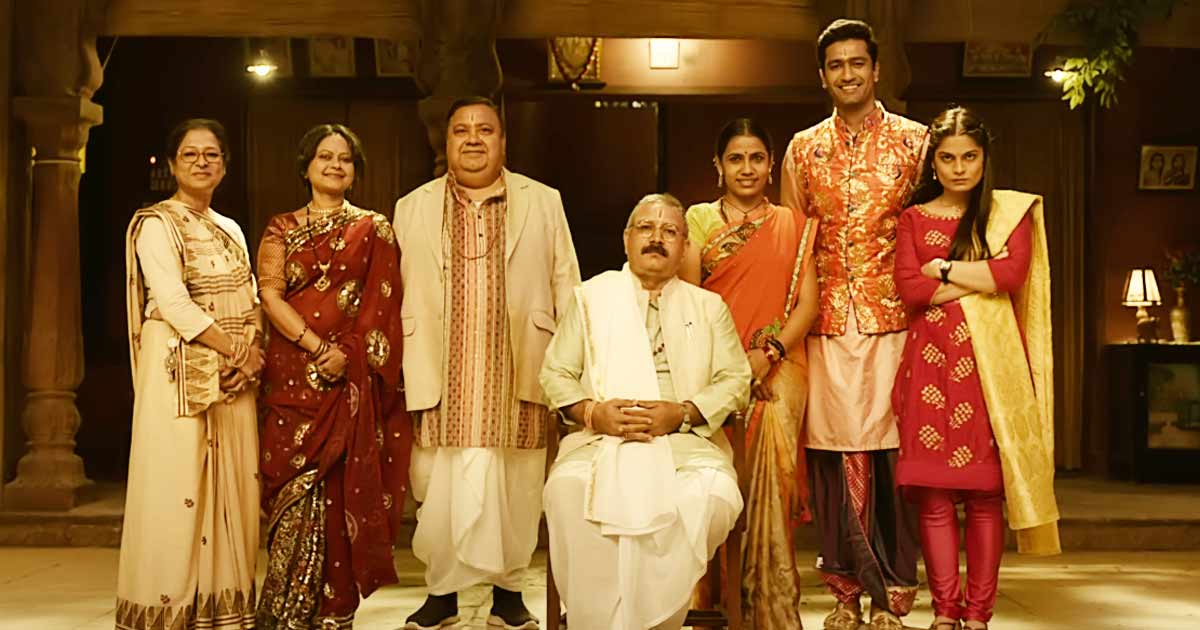The Great Indian Family Ending Explained

In the realm of cinema, a well-crafted ending has the power to leave an indelible mark on viewers, and 'The Great Indian Family,' directed by Vijay Krishna Acharya, accomplishes just that. This film not only delivers a satisfying conclusion but also weaves a compelling narrative around love, identity, and tradition. In this exploration, we dissect the emotional crescendo of the movie's ending and decode the hidden messages that make it a cinematic masterpiece.
A Tale of Identity and Unity: A Recap
Before delving into the ending, it's essential to recap the film's core elements. 'The Great Indian Family' introduces us to Bhajan Kumar, played by the versatile Vicky Kaushal. Bhajan is a devout Hindu man known as the spiritual icon Bhajan Kumar, celebrated for his soulful renditions of Hindu devotional songs.
However, Bhajan's life takes an unexpected twist when he stumbles upon a letter that reveals his Muslim heritage. This revelation shakes the very core of his identity, forcing him to confront the stark contrast between his public persona and his private desires. As Bhajan grapples with this identity crisis, the film unravels the complexities of interfaith relationships, love, and unity against the backdrop of a typical Indian family.
The Climactic Moments: What Led to the Ending
To comprehend the ending, we must first delve into the pivotal moments that pave the way for the film's conclusion. Central to these moments is Bhajan Kumar's internal struggle, torn between the expectations of his conservative Hindu family and his newfound awareness of his Muslim heritage.
Throughout the film, we witness Bhajan's emotional journey as he navigates the challenges of reconciling these two facets of his identity. His relationships, particularly his love story with Jasmeet (Manushi Chhillar), play a pivotal role in shaping his perspective and his choices.
As the narrative unfolds, Bhajan's internal conflict intensifies, culminating in a sequence of events that forces him to confront his family, society, and, most importantly, himself. It is within these critical moments that 'The Great Indian Family' reaches its emotional zenith, setting the stage for a profound and poignant ending.
Decoding the Ending of 'The Great Indian Family'
)
Now, let's delve into the heart of the matter: the ending of 'The Great Indian Family.' As Bhajan Kumar's internal and external worlds collide, the film propels us towards a resolution that is thought-provoking and emotionally resonant.
1. Bhajan Kumar's Revelation: The climax of the film centers around Bhajan Kumar's decision to reveal his Muslim heritage to his family and the residents of Balrampur. This moment brims with tension, as conservative Hindu society grapples with the shocking revelation. It's a testament to the film's exploration of identity and unity, as it forces characters and viewers alike to confront preconceived notions and prejudices.
2. The Power of Love and Acceptance: Central to the ending is the theme of love and acceptance. Bhajan's relationship with Jasmeet, a strong and independent woman, symbolizes the bridging of cultural and religious divides. Their love serves as a beacon of hope in a world marked by divisions. The film emphasizes that love transcends labels and underscores the importance of embracing diversity within the folds of unity.
3. Resolving Family Dynamics: The ending also sees a resolution of the family dynamics that have been a recurring theme throughout the film. Bhajan's family, initially conservative and resistant to change, undergoes a transformation. Their journey mirrors that of Bhajan, as they grapple with his revelation and ultimately choose acceptance and love over prejudice.
4. Finding Inner Peace: For Bhajan Kumar, the ending is not just about external acceptance but also about finding inner peace. His journey of self-discovery culminates in a sense of resolution and a deep understanding of his own identity. He learns that one's heritage does not define their worth, and true spirituality lies in embracing diversity and spreading love.
The Symbolism of the Final Scene:
Like many great films, 'The Great Indian Family' employs symbolism in its final scene to drive home its core messages. The film concludes with a poignant shot of Bhajan Kumar standing at the confluence of two rivers, symbolizing the merging of his dual identities. This powerful imagery encapsulates the central theme of unity in diversity, where the blending of two distinct elements results in something beautiful and harmonious.
Bhajan Kumar's choice to embrace both his Hindu and Muslim heritages, reflected in his attire and the songs he sings, serves as a visual metaphor for the film's overarching message. It conveys the idea that one can honor their roots while embracing the richness of other cultures and traditions.
The Impact of the Ending: Why It Resonates

The ending of 'The Great Indian Family' resonates on multiple levels, leaving a profound impact on viewers. Here's why it strikes a chord:
1. Universal Themes: The film's exploration of identity, love, and unity transcends cultural boundaries. It speaks to the universal human experience of grappling with questions of self-identity and the power of love to bridge divides.
2. Relevance in Today's World: In a globalized world marked by increasing cultural diversity and interconnectedness, the film's message of acceptance and unity is particularly relevant. It serves as a reminder of the importance of embracing diversity in an increasingly pluralistic society.
3. Emotional Catharsis: The film's ending offers a sense of emotional catharsis. Viewers are taken on a transformative journey alongside Bhajan Kumar, and the resolution provides a satisfying sense of closure and enlightenment.
4. Thought-Provoking Reflection: 'The Great Indian Family' leaves viewers with much to ponder. It encourages reflection on one's own identity, the role of tradition in shaping our lives, and the capacity of love to break down barriers.
Conclusion: Unlocking the Beauty of 'The Great Indian Family' Ending

In conclusion, the ending of 'The Great Indian Family' is a testament to the film's storytelling prowess and its ability to navigate complex themes with grace and sensitivity. It serves as a powerful reminder that our identities are not confined to labels but are shaped by our experiences, our capacity to love, and our willingness to accept others for who they are.
The film's closing moments encapsulate the very essence of unity in diversity, urging us to embrace the richness of different cultures and traditions while honoring our own heritage. It's a message that reverberates long after the credits roll, leaving us with a renewed sense of appreciation for the beauty that arises from harmony amidst diversity.
'The Great Indian Family' invites us to celebrate our shared humanity and the unbreakable bonds that connect us all, transcending the boundaries of faith, tradition, and identity. It's an ending that not only satisfies our cinematic sensibilities but also touches the depths of our souls, leaving us with a profound sense of hope and understanding.

